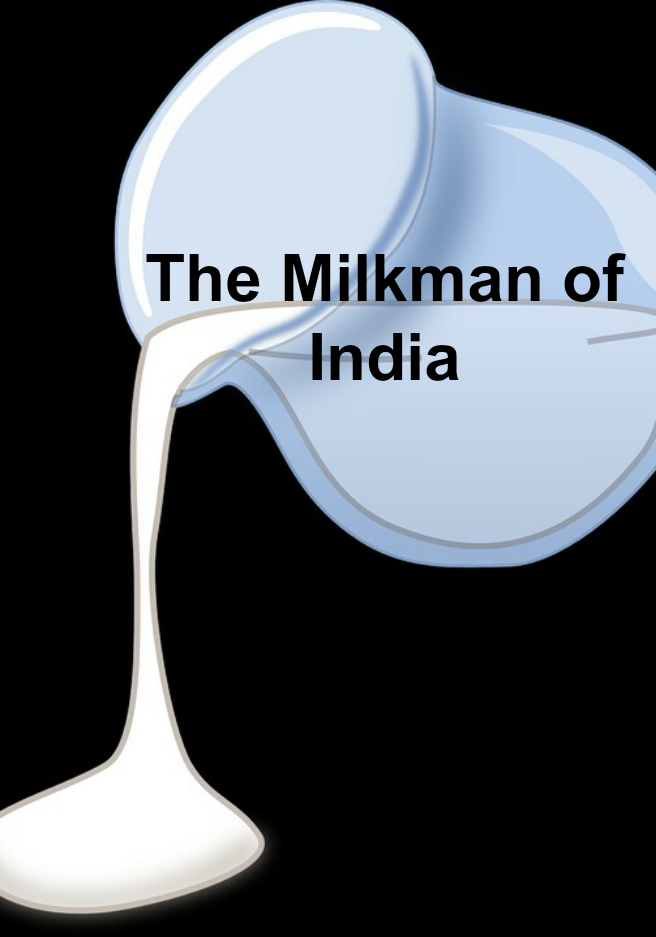The Milkman Of India
The Milkman Of India


A physics graduate with a bachelor's degree in mechanical engineering from Madras University applied for a scholarship provided by the government of India to study dairy engineering. He went to the Imperial Institute of Animal Husbandry in Bangalore (now, National Dairy Research Institute, southern station, Bengaluru) where he spent nine months before being sent to America to study at Michigan State University, on a government scholarship. However, he cheated a bit and returned with a master's degree in mechanical engineering (metallurgy) with a minor in nuclear physics, which he thought were the disciplines likely to be of far greater use to his soon-to-be independent country and him. It was in the year 1948. In 1949, he was sent by the government of India to its run-down, experimental creamery at Anand, a place in the Kaira district of Gujarat, to serve five years as an officer in the dairy division. For a 27-year-old young, independent-minded man, this prospect was quite disheartening.
On arriving at Anand, he found that the farmers were being exploited by the distributors of milk and the entire region was controlled by a shrewd but clever businessman called “Pestonjee Edulji” who marketed Polson butter. Tribhuvandas Patel was the leader of the farmers who was trying to unite them and form a cooperative movement against exploitation. It was a struggling cooperative without any proper processing facilities to prevent the milk from curdling by the time it reached Mumbai. Touched by the plight of the farmers, he left his government job and joined forces with Tribhuvandas Patel and the farmers to start the Milk Cooperative movement in the region registered under the name of Kaira District Cooperative Milk Producers Union Ltd (KDCMPUL), which was later renamed to now popular “Amul”. Yes, the man is no other than Dr Verghese Kurien. AMUL, which stands for Anand Milk Union Limited, today is jointly controlled by 36 lakh milk producers in Gujarat, and the apex body of 13 district milk unions, spread across 13,000 villages of Gujarat. The word “Amul” is derived from the Sanskrit word ‘Amulya’ which means ‘priceless’ or precious. Dr Kurein was responsible for turning India from a milk deficient country to the largest producer of milk in the world today. During the initial years of its foundation, the farmers faced the problem of fluctuating milk production as surplus milk found no buyers in the flush season. Kurien's batchmate from America and dairy engineer H. M. Dalaya invented the process of making skim milk powder and condensed milk from buffalo milk instead of from cow milk. It was a technological breakthrough. In India, buffalo milk was plentiful, while cow milk was in short supply, unlike in Europe. As a result, Amul competed successfully against reputable companies from the West. When Kurien visited Nestle in Switzerland and asked them to reduce Indian imports and have more Indians inducted, they told him that making condensed milk "could not be left to the natives". Determined, he returned to India and boosted Amul's production and market of condensed milk. Amul also faced serious competition from imported butter, especially from New Zealand. The government trusted him and banned imports of butter. Kurien delivered an incremental increase in his production to eliminate the butter shortage, as promised. Kurien also suggested a mischievous little girl as a mascot that would grab the attention of every housewife in the country. The Amul Girl, dressed in a polka-dotted frock with blue hair and a half pony tied up, created by Mr Sylvester Da Cunha, has often been described as one of the best Indian Advertising concepts because of its humour. Many important institutions were established under Dr Kurien's leadership, namely the GCMMF (Gujarat Cooperative Milk Marketing Federation Ltd) and NDDB (National Dairy Development board which played a significant role in shaping the Dairy Cooperative movement across the country and led the replication of Anand model of cooperative dairy practised all over the country. India became the world's largest milk producer by 1998, surpassing the United States of America with about 17 per cent of global output in 2010–2011.
Dr Verghese Kurien is rightly known as the 'Father of White Revolution in India, whose idea 'Operation Flood', made dairy farming India's largest self-sustaining industry and the largest rural employment sector providing a third of all rural income. His enduring personality, spirit, undying charisma and conviction for turning the impossible into possible won him many accolades such as the Ramon Magsaysay Award for Community Leadership (1963), Padma Shri (1965), Padma Bhushan (1966), Krishi Ratna Award (1986), World Food Prize (1989), Padma Vibhushan (1999), Economic Times award for Corporate Excellence (2001) and several other awards. But the best award that the people of the country gave him was the title “Milkman of India”. Filmmaker Shyam Benegal wanted to make Manthan ("churning of the milk ocean", in Hindu mythology) a story based on Amul, but lacked funds. Half a million farmers contributed two rupees to make the movie, which was released in 1976. 'Manthan' was a global success and the UNDP used the movie to start similar cooperatives in Latin America and screened it in Africa. In September 2012, when Kurien breathed his last, the always cheerful Amul girl cried for the first time and so did the million farmer families whom Kurien had given hope and Amul. Dr Kurien had said, “I am in the business of empowerment. Milk is just a tool in that”. He couldn’t have expressed it better.






























































